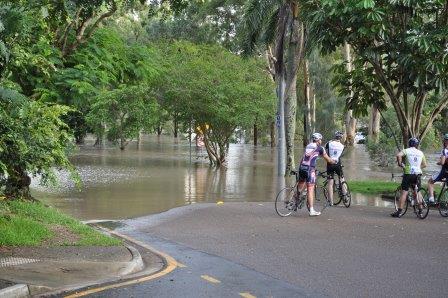Melbourne studies extreme weather
Variations in high-altitude wind patterns expose particular parts of Europe, Asia and the US to different extreme weather conditions, a new study has shown.
Changes to air flow patterns around the Northern hemisphere are a major influence on prolonged bouts of unseasonal weather—whether it be hot, cold, wet or dry.

The high altitude winds normally blow from west to east around the planet, but do not follow a straight path. The flow meanders to the north and south, in a wave-like path. These wave patterns are responsible for sucking either warm air from the tropics, or cold air from the Arctic, to Europe, Asia, or the US. They can also influence rainfall by steering rain-laden storms.
Pioneering new research, carried out by the University of Exeter and the University of Melbourne, has shown that the development of these wave patterns leaves certain Northern Hemisphere regions more susceptible to different types of prolonged, extreme weather.
Dr Screen, a Research Fellow at the University of Exeter and lead author of the study, said, “The impacts of larger atmospheric waves are different in different places. In some places amplified waves increase the chance of unusually hot conditions, and in others the risk of cold, wet or dry conditions.”
The study showed that larger waves can lead to droughts in central North America, Europe and central Asia, and western Asia exposed to prolonged wet spells.
It also shows western North America and central Asia are more prone to heat waves, while eastern North America is more likely to experience prolonged outbreaks of cold.
The collaborative study used detailed land-based climate observations to identify episodes of abnormal temperature and rainfall from 1979–2012 and then examined the wave patterns during these events.
Co-author Professor Ian Simmonds, from the Melbourne School of Earth Sciences, said the weather extremes they examined were month-long heat waves, cold spells, droughts and prolonged wet periods, which occurred over large areas.
He said, “The study revealed that these types of events are strongly related to well-developed wave patterns, and that these patterns increase the chance of heat waves in western North America and central Asia, cold outbreaks in eastern North America, droughts in central North America, Europe and central Asia, and wet spells in western Asia.”
“The findings are very important for decision makers in assessing the risk of, and planning for the impacts of, extreme weather events in the future.”
“Amplified mid-latitude planetary waves favour particular regional weather extremes,” by Dr James Screen and Professor Ian Simmonds, is published in Nature Climate Change.
Melbourne School of Earth Sciences
The Melbourne School of Earth Sciences was formally established in 1990, following the amalgamation of the Department of Geology (1900) and the Department of Metrology (1937). Since its inception, the School has gained a national and international reputation for innovative research and teaching in the inter-disciplinary fields of Geological Sciences and the Atmospheric & Ocean Sciences. The School offers a wide range of undergraduate Science and Breadth subjects across these discipline areas, as well as several postgraduate degrees.
Located just north of the Melbourne downtown central business district, the Melbourne School of Earth Sciences forms part of the vibrant Parkville campus environment and represents an exciting learning environment.
The Master of Science – Earth Sciences offers two streams: one in Atmospheric Science and the other in Geology. In both streams students undertake core and elective coursework subjects, at least one Professional Tools subject of choice, and a research project.
As a graduate of this program, one can find a rewarding career in government organisations, research institutions, environmental consultancies, and the oil, gas and mining industries. Potential career opportunities include
- Climatologist
- Energy specialist
- Environmental consultant
- Environmental geologist
- Exploration geologist
- Geological surveyor
- Mine geologist
- Researcher
- Resources geologist
- Weather forecaster
*

































Ask A Question
Ask us about your program of interest, or if you have a question about our services.
CONTACT US TODAY